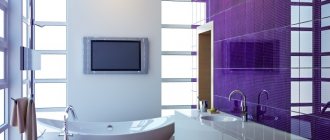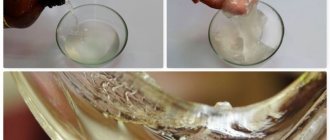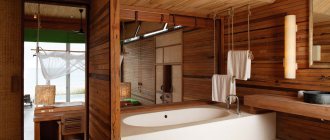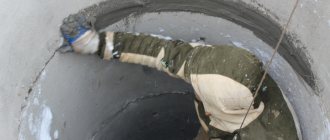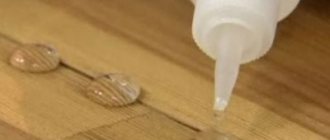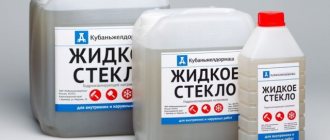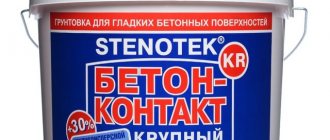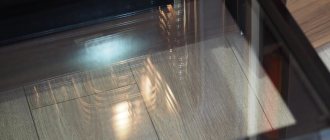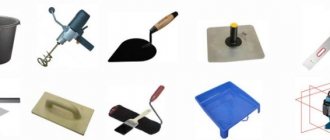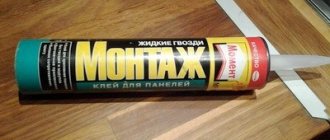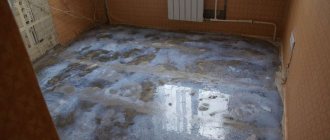Waterproofing the floor protects it from water coming from both outside and inside the room. Without it, any subfloor will suffer greatly from condensation and moisture, and its service life will be significantly reduced, especially when it comes to wooden coverings and products. To protect them from water, a variety of substances are used, of which a great variety is now on sale. This type of waterproofing composition, such as liquid glass for floors, is in great demand.
Liquid glass for floors
What it is?
Waterproofing floors is necessary during the construction of any building. It can also be done during screed repairs in an apartment or house. To create a layer that protects against water and condensation, a variety of materials can be used, differing in their physical and chemical characteristics, as well as in the type of action they provide.
Liquid glass - what is it
So, they distinguish:
- rolled materials (polyethylene, roofing felt);
- penetrating (penetrates concrete and creates strong connections);
- injection compounds (introduced into cavities in concrete);
- coating type of protection against moisture penetration (mastic).
Laying roll waterproofing in the bathroom
Liquid glass belongs to the category of coating waterproofing agents. It is easy to use and has high protective qualities. Liquid glass contains sodium silicates or potassium compounds and water. During production, soda and quartz sand are used, which are fired, or silicon dioxide, treated with alkali in an autoclave. When frozen, glass becomes very hard and neither air nor water can penetrate through it. But it itself, on the contrary, is capable of penetrating into the thickness of the base or other structure being processed.
Liquid glass ELKA AK
On a note! Externally, liquid glass for waterproofing strongly resembles ordinary stationery silicate glue. And, in general, the substances are very similar in their properties; they differ, in essence, only in some components. For example, waterproofing liquid glass contains special modifiers that significantly increase the protective properties of the material.
Liquid glass application process
Prices for liquid glass for waterproofing
liquid glass for waterproofing
Why do tiles come off the floor?
The most important reason is that the technology for laying the flooring is broken, which consists of many factors. Let's look at them:
First of all, this is a poorly made base for the floor. The screed must be laid from M-100,150 mortar in order to have the necessary strength and thickness necessary to obtain a level surface.
No primer was applied to ensure better adhesion between the glue and the base. Before priming, it is necessary to clean the surface and remove dust.
The adhesive mass was not prepared according to the instructions, that is, there was a violation in the proportions of the constituent components, which affected its quality.
The adhesive mixture was not applied to the entire area of the tiles, which led to the formation of voids, which means there was no continuous adhesion of the tiles and the adhesive composition.
We just decided to save money and applied a thinner layer of glue and not over the entire area. As a result, the tiles on the floor move away from the base.
To control from practice, I can cite the average glue consumption rate in our company - 6 kg per 1 m2 of tile covering (with glue thickness = 4 mm). It can, of course, be more (up to 10mm) if there are uneven bases.
In addition, if the house was recently built and stands on subsiding soils, then during settlement in the first year the screed could simply crack. The soil is to blame here, and to prevent this from happening, you had to reinforce the screed with a light mesh with a diameter of 4 - 6 mm.
Properties and applications of liquid glass
The composition applied to the base, hardens, turns into a fairly durable coating, which really strongly resembles glass in many of its properties. It protects concrete from moisture, makes it stronger, and prevents the material from absorbing water. In appearance, liquid glass is transparent, durable, turns into a reliable barrier to water, but is somewhat fragile, like ordinary glass.
On a note! Liquid glass has been used in a variety of fields for 200 years.
Liquid glass is used in a variety of fields
Liquid glass is actively used in construction. It is suitable for:
- protection of rough foundations from water exposure;
- protection of plastered surfaces;
- improving the properties of the concrete mixture used to create swimming pools;
- protection of seams between building materials;
- creation of paint and varnish products;
- imparting antiseptic properties to coatings and materials;
- use as a hardener additive;
- corrosion protection;
- reducing the fire hazardous properties of materials.
Liquid glass as an antiseptic
There are two types of liquid glass, which is due to the difference in the chemical composition of the substance.
Table. Types of liquid glass.
| View | Description |
| Sodium | This glass contains sodium silicate. The substance is compatible with various materials and has excellent adhesive properties. It is not afraid of external natural factors and can be used in any conditions. It is often used in the production of household chemicals, to create paper and glass, to increase the strength of foundations, and plays the role of an antiseptic. |
| Potassium | The base is potassium nitrate. Like the previously described type, it is not afraid of moisture and withstands weather conditions and chemicals well. The main difference between potassium glass and sodium glass is the lack of shine and glare in the former. Thus, the composition can be used for exterior work and for the production of paints and varnishes. |
Basement waterproofing with liquid glass
Liquid glass is packaged in containers ranging from 500 ml to 10 liters. The manufacturer must be indicated on the packaging, as well as recommendations for use. The production and storage of the material is regulated by GOST 13078-81. Less commonly, but still available for sale, granulated glass or produced in powder form. This type of liquid glass is called Monasil. It is diluted with water during preparation in accordance with the proportions and requirements indicated on the package.
GOST 13078-81. Liquid sodium glass. Technical conditions. Downloadable file (click the link to open the PDF in a new window).
GOST 13078-81
Sodium liquid glass
On a note! Waterproofing is the most common area of application of liquid glass. This option for protecting surfaces from water is inexpensive and simple, but at the same time highly reliable.
Advantages and disadvantages
Why is liquid glass so good that it is so often used in the construction industry? Why is it sometimes indispensable? All thanks to the advantages of this material:
- liquid glass has excellent adhesive properties, which allows it to penetrate deep into the structure of the material being processed;
- the composition can be used to coat products made of wood, concrete, metal, stone;
- the composition is moderately fluid, but at the same time quite viscous, due to which the coating from it will be reliable and uniform;
- the consumption of this substance is minimal. If you compare liquid glass with rubber, then you will need half as much of the former as the latter;
- The price of the material is low, liquid glass is the most affordable way to protect the surface from moisture.
Liquid glass has many advantages
On a note! You need to work with liquid glass quickly; it is advisable to apply the composition in one approach, without leaving uncoated areas. Only then will the treated surface be reliably protected.
Liquid glass also has disadvantages. In its pure form, such a coating turns out to be quite fragile, and even a small blow can destroy it. Also, the composition cannot be applied to brickwork, because it will collapse quite quickly. The disadvantages include the need to quickly work with the substance, and the fact that it will be impossible to apply a finishing coating to such a layer - paint and varnishes do not stick to liquid glass.
How to work with liquid glass
Waterproofing with liquid glass
If you use such glass as a waterproofing material, then it does an excellent job of filling all the cracks and cracks in concrete, plaster, and closing all small pores. This will make the base stronger and protect it from water.
Impregnation of floor screed with liquid glass
In this case, liquid glass is simply applied to the prepared base. It can be applied using a wide spatula or brush. This method of waterproofing is called coating. It is recommended to carry out it if the base is porous and friable, dusty and prone to abrasion. For these purposes, sodium composition of liquid glass is usually used.
The subfloor must be prepared before processing. It is leveled, if necessary, sanded, all debris and dust are removed from it. It is also recommended to degrease the surface to increase adhesion.
After application, liquid glass hardens within 30-60 minutes. After the first layer has dried, a second can be applied to it, which will make the waterproofing layer more reliable.
Liquid glass Bau Gut
How to replace grout with new one
Removing old grout from seams with a cleaning knife
Most often, the grout of old cement-based seams needs to be replaced. Since its service life is short, it may crumble or become infected with fungus. Unfortunately, the seam of newly laid grout can crack due to the fact that the appropriate conditions were not created, for example:
- Too much water has been added to the composition.
- The density of the tiles is not taken into account - the porous material quickly absorbs moisture from the fugue, which is why it dries out very quickly.
- The base is not stable. In this case, the cement-based fugue will constantly crack, no matter how many times it is changed.
- Incorrect grout for wide joint.
Removing old fugue from seams
There may be other reasons (maybe you need to make a seam of a different color), but we have given the main ones. Now let's look at what needs to be done to grout the seams with a new fugue.
So, we need to remove the old grout. You will learn how best to do this in the following video.
Use with concrete
Liquid glass can also be added to the concrete mixture when pouring the screed. This will make the base stronger and more reliable, and will also give it waterproofing properties. Such concrete is often used to create swimming pools, wells, stoves and fireplaces.
Concrete
On a note! The heat resistance of concrete when adding liquid glass increases to 1000 degrees. For the standard composition it is approximately 200 degrees.
The material also increases the thermal insulation properties of concrete. By the way, it can only be added to cement grades M300 and M400. The maximum amount of liquid glass in a concrete mixture cannot exceed 10% of the total mass of the solution, while the optimal option is when only 7% of the composition is added to the concrete. The initial setting of the mixture at an air temperature of about 16-20 degrees occurs:
- within 45 minutes – with the addition of 2% glass;
- for 30 minutes - at 5% of the composition;
- in 10 minutes - with the addition of 8% glass.
Mixing concrete with liquid glass
In any case, the screed must dry for at least 28 days before full use begins. But you need to use a composition prepared on the basis of cement and liquid glass very quickly - preferably within 10-12 minutes.
Important! Liquid glass is never added to ready-made cement mortar. First, it is diluted with water, and then dry cement powder is added to the resulting mixture. Then the mixture is thoroughly mixed.
Products of different brands
Rules for working with material
Use protection when working with aggressive liquids To ensure a durable coating, you must follow the following rules:
- the temperature range should be from -5 to +30 degrees;
- You need to prepare the mixture in small portions, as it hardens quickly;
- When applied to a metal surface, it must be degreased.
Do not add material undiluted with water to ready-made plaster or cement mortar. We add it in the form of an aqueous solution in compliance with the proportions.
How to choose liquid glass for waterproofing
Choosing the composition is easy. The fact is that, despite the manufacturer, the components of all compositions are the same. Therefore, you can choose the brand that you like best. Of course, depending on the sonority of the name and the transportation distance, the cost of liquid glass compositions will vary significantly, but in general this material is inexpensive.
Sodium liquid glass
And with regard to liquid glass, the principle “the more expensive, the better” is not used. Therefore, you will essentially have to choose from only two types - sodium or potassium. Sodium glass is recommended for processing various surfaces, and potassium glass is recommended for floors and foundations, as it has high viscosity. Thus, for waterproofing the floor or for mixing into the composition to create a screed, it is recommended to buy potassium glass.
Liquid glass BITUMAST
How to restore the integrity of the coating
Naturally, before work on restoring the surface, you need to remove hundreds of old mortar and all dirt along with dust. Next is priming. This is mandatory and cannot be skipped. After this, you need to choose the most suitable adhesive composition for you:
- Remains of the dry mixture used during installation. The printing option is ideal, since the solution can be mixed in the quantity required and the glue itself will not differ from the one already used in its characteristics.
- Cement mortar. It will help in cases where it is necessary to fill voids under adjacent tiles that have peeled off. You just need to make it a little more liquid than when laying it and fill the existing voids.
- New adhesive composition. Buying it in a store is as easy as shelling pears, but before buying, you need to consult with the manager and find out whether it is suitable according to its characteristics in your case.
Necessary tools and materials for waterproofing
In order to treat floors with liquid glass, you will not need many materials and tools:
- brush and spatula - for applying the composition;
- directly the liquid glass itself;
- water, if you need to dilute the composition;
- rags - to remove drops of the composition that fall where they should not;
- container - for pouring liquid glass in order to achieve ease of use;
- degreaser - will be needed for pre-treatment of the subfloor;
- broom, dustpan, vacuum cleaner and other cleaning equipment - to clean the surface being treated.
Cleaning the subfloor
Advice! When working with liquid glass, it is recommended to wear old clothes that you don’t mind getting dirty, as well as gloves and a mask. So these items should also be prepared in advance.
Preparing for work
Before you begin directly gluing the tiles, you need to prepare the following materials and tools.
- Tile adhesive;
- Glue spatula;
- Plastic spacer crosses.
In addition, you should always have a building level, a tape measure and a marking pencil on hand.
In order not to spoil your clothes with stains, it is better to work in a protective gown and gloves. The preparation of the surfaces themselves plays an important role. The quality of fixing the tiles and the convenience of the work itself depend on how smooth the walls and floors are. On a leveled surface, glued tiles look much more aesthetically pleasing.
How is waterproofing done with liquid glass?
Let's look at how the process of waterproofing a concrete base in a garage with liquid glass occurs.
Step 1. First of all, the base is freed from all objects that may interfere with the work. There should be nothing in the room. Next, the base is cleaned first with a broom (large debris is swept away), and then treated with a vacuum cleaner. In some cases, wet cleaning is recommended.
Preparing the concrete base
Step 2. Prepare all the necessary equipment for work. According to the instructions, liquid glass is poured into the container in the required quantity.
Liquid glass is poured into a container
Step 3. Starting from the far corner of the room, liquid glass is applied to the base with a brush. Corners and joints between walls and floors are carefully coated. The layer is applied evenly so that there are no uncoated areas left.
Applying the first layer of liquid glass
Step 4. The first layer is dried for 30 minutes. Next, a second layer of liquid glass is applied in the same way. However, experts recommend applying the second layer slightly differently: a little of the composition is poured onto the treated base and leveled over the surface with a wide spatula.
Applying a second layer
Sometimes, instead of a second layer, a so-called protective layer can be applied. It is a cement mortar diluted with liquid glass in a 1:1 ratio. It is applied with a spatula and dried. Thus, a reliable and strong foundation is obtained.
Video - Liquid glass on a concrete floor
Volumetric floor
A type of liquid glass waterproofing is a coating technology with a 3D effect. To obtain a three-dimensional image, apply 3 layers:
- base polymer layer;
- drawing or photograph made on banner fabric;
- final polymer layer 3-4 mm thick.
The volume of the image depends on the height of the last layer, but it is not recommended to apply it more than 4 mm. The service life of glass coating with 3D effect is more than 10 years. It is very durable and resistant to mechanical stress.
Liquid glass floor decor
If floors treated with liquid glass are not covered with finishing material on top, then even then they can be decorated a little by changing the gray and boring color of concrete to something bright. In this case, the paint is applied to the concrete before covering the base with liquid glass. To make the material stick better, it is mixed with liquid glass before application (add 5-10% is enough).
On a note! Do not confuse liquid glass with the material used to create self-leveling floors. Yes, they are also sometimes called “liquid glass” or “glass floor”, but these are completely different materials and a completely different technology.
Liquid glass. Application in construction
Liquid glass, as we found out, is an excellent and inexpensive way to protect the base from water. The material is easy to find in any hardware store, and even an inexperienced craftsman can handle the application. The main thing is to work quickly so that the liquid glass does not have time to harden.
Safety precautions during operation
It is recommended to wear rubber gloves and boots when applying glass waterproofing coating.
When diluting liquid glass, a strong alkaline reaction occurs, so you need to prepare a large container with clean water and vinegar.
A weak vinegar solution will neutralize the alkali if it comes into contact with the skin.
When pouring a glass coating, you need to protect the room from drafts. To do this, do not turn on the air conditioner and heating devices until the base is completely dry.
